- Experimental analysis of single cylinder four stroke ceramic coated diesel engine powered with biodiesel blends
T. Ganesana, K. Muruganb,*, R. Prakashc and N. Kathiravand
aDept. of Automobile Engineering, Mahendra Institute of Technology, Namakkal, India – 637503
bDept. of Automobile Engineering, Mahendra Institute of Technology, Namakkal, India – 637503
cDept. of Mechanical Engineering, AVS College of Technology, Salem, India – 636106
dDept. of Mechanical Engineering, KGISL Institute of Technology, Coimbatore, India – 641035This article is an open access article distributed under the terms of the Creative Commons Attribution Non-Commercial License (http://creativecommons.org/licenses/by-nc/4.0) which permits unrestricted non-commercial use, distribution, and reproduction in any medium, provided the original work is properly cited.
This study focuses on analysis of an alternate fuel, which will control the increasing levels of emission affecting the quality of air. Biodiesel are produced from vegetable seed non - edible oil and also from animal fat. The seeds of Calophyllum Inophyllum are mainly available in Ramanathapuram district, India and they are used for extracting the biodiesel. Transesterified Calophyllum Inophyllum oil methyl ester (CIOME) is tested for the engine performance and emission characteristics of a diesel engine. Also, Rice bran extract from boiled rice bran oil is also transesterified to Rice bran oil methyl ester (RBOME) and it is also tested and compared with CIOME for engine performance characteristics and emission characteristics. The engine performance and emission characteristics of the ceramic coated diesel engine revealed that biodiesel blend of CIOME and RBOME results in improved performance in the engine characteristics. The significant NOx emission is reduced 7 to 22% was obtained for all CIOME compared to the RBOME and pure diesel
Keywords: Calophyllum inophyllum oil methyl ester, Transesterification process, Bio diesel, Engine performance, Engine emission
A World Health Organization (WHO) report has revealed that 13 out of 20 cities in the world are most polluted. India holds the dubious distinction of being the most polluted is announced by the Central Pollution Control Board (CPCB), Delhi [1]. CPCB has flagged 5 pollutants such as SO2, NO2, CO, PM2.5 and O3 as the major contributory factor in releasing emission out in the open atmosphere [2]. Admittedly, the pollution is caused by unchecked and unmitigated automobile emission levels thereby destroying the air quality [3]. The generation and usage of biodiesels are used in several industrial applications [4].
The Calophyllum Inophyllum seed oil (known widely in Tamil as Punnagam oil) is used in this experiment. The (CIO) is non-edible oil cultivated in the vast expanse of East Africa, Malaysia, Australia and southern Coastal India. The tree is grown extensively in Maharashtra and coastal area of Tamil Nadu and Andamans [5]. It has a low hanging branch and takes longer time to grow. Height of the tree is normally 8 m to 20 m, the leaf is of an elliptical shape. The fruit has a green drupe and is round in shape [6]. Diesel engine characteristics using multi-walled carbon nano tubes are studied [7]. The multi walled carbon nano tubes blended in several proportions with bio-diesel from vegetable oil refinery by products are used to investigate BSFC, emission analysis of the diesel engine it’s reported that the SFC is significantly reduced and brake thermal efficiency is increased [8]. The exhaust gas temperature is decreased for most of the biodiesel blends. When the blends of the biodiesel are in the percentage of 5, 10 and 15 percentage, the CO emission is found to be 7.1%, 17.7% and 14.5% respectively. The Nitrogen oxide emission is also found to be considerable reduced to 9.2% for the biodiesel blending is compared with the neat diesel [9]. The engine emission characteristics of the diesel engine fuelled with the biodiesel, biodiesel-bioethanol emulsions are investigated [10]. The carbon monoxide, carbon dioxide and smoke opacity also found to be decreased with the usage of biodiesel blends and provide better emission characteristics [11]. The cotton seed biodiesel are used as additive for silicon oxide and cobalt oxide and produces better emission characteristics [12].
The Calophyllum Innophyllum is de-husked first and converted into Calophyllum Innophyllum Oil methyl ester CIOME. It consists of diesel properties that can be used in a diesel engine [13]. The calorific value of the fuel is based on the rate of fuel consumption and heating value of CIOME, Calophyllum Innophyllum tree can be extracted from Calophyllum Innophyllum seeds. The seed is pretreated and dried and later the oil is extracted from the crushed Calophyllum Innophyllum seed [14]. The transesterification process is carried out to obtain biodiesel Calophyllum Innophyllum Oil methyl ester CIOME. Rice bran oil is extracted from rice bran. The outer layer (husk) of the rice grain is removed for the extraction of the rice bran oil methyl ester. It's a by-product of rice milling. The oil extraction machine is used to extract RBO as shown in Fig. 6 and the rice bran has 21.44% of raw oil and mild flavor higher smoke point higher that of 232 °C (450 °F) [15,16].
In the esterification process, the Free Fatty Acid content is reduced. The esterified (CIO) was preheated to the constant temperature of 60 °C by using a heating and stirred continuously during the process at 1hr 30 min. Then 5 ml Potassium hydroxide (KOH) is mixed to the mixture [17,18]. After that, the prepared mixture that of methanol and Sodium hydroxide (NaOH) were added, in this process, the temperature was maintained at 50 °C and the mixture was stirred constantly for 2 hours. Finally the Free Fatty Acid and Glycerin was removed from this transesterification process [19]. The biodiesel plant which is used for the transesterification is shown in the Fig. 1.
The density of the CIOME 15 °C is 874 kg/m3 and RBOME is 868 kg/m3. The value of density for pure fuel at same temperature is found to be 824 kg/m3 [20-22]. Similarly the fuel properties are compared with the pure diesel and it is evidence that the values are very close to the pure diesel and proved that it is an alternative for the conventional diesel engine [23].
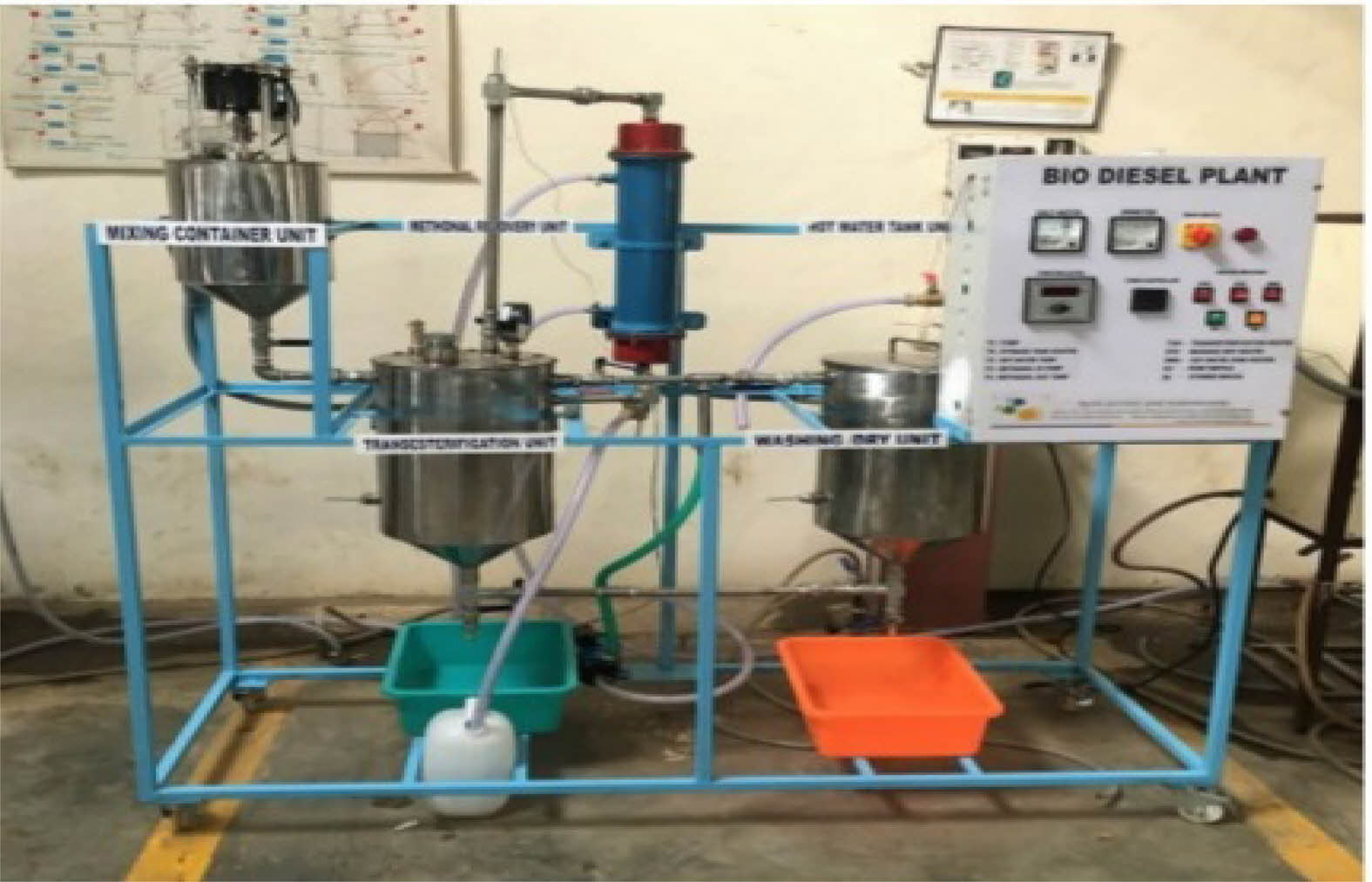
|
Fig. 1 Transesterification Biodiesel plant. |
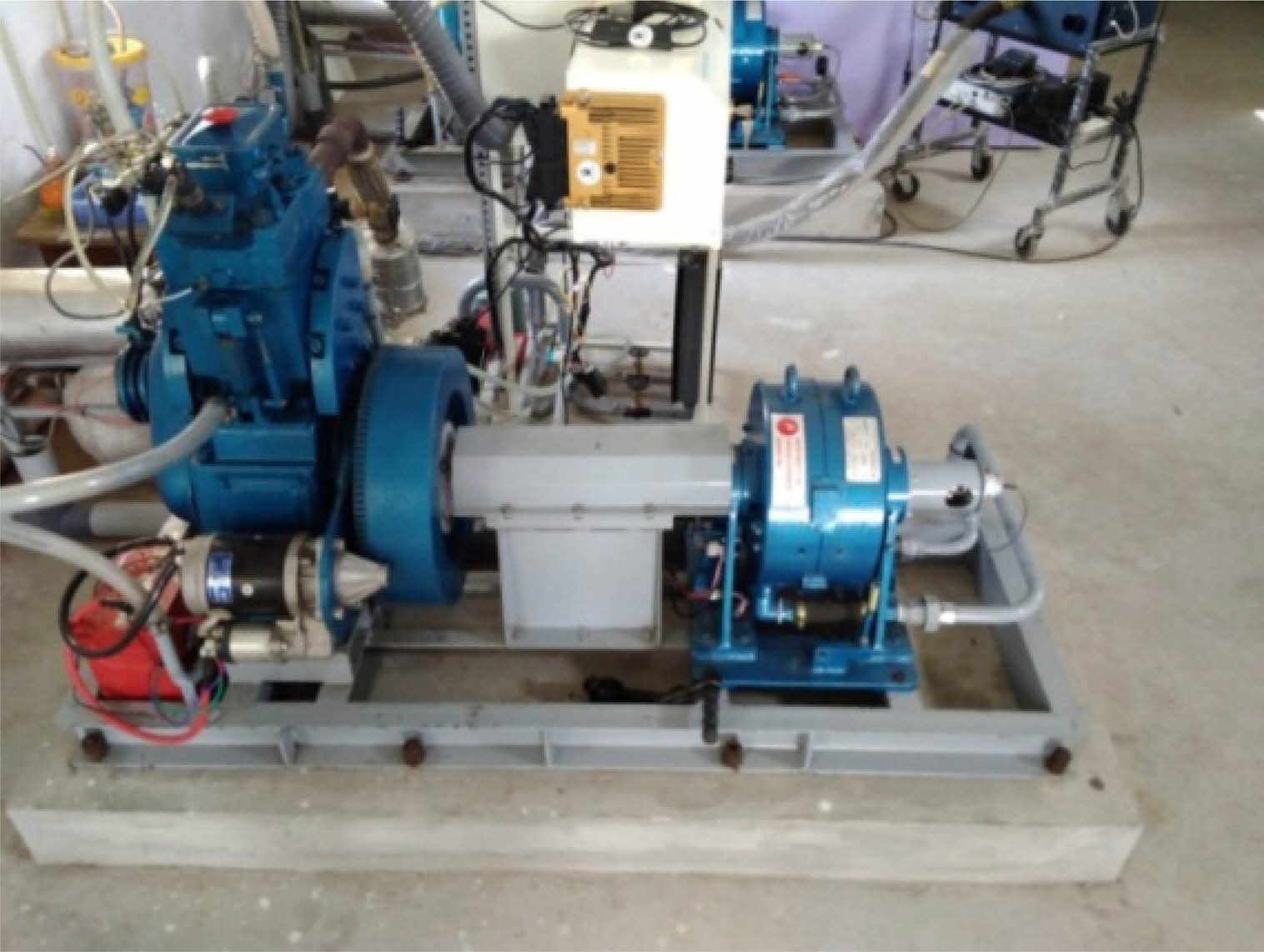
|
Fig. 2 Schematic layout of experimental setup. |
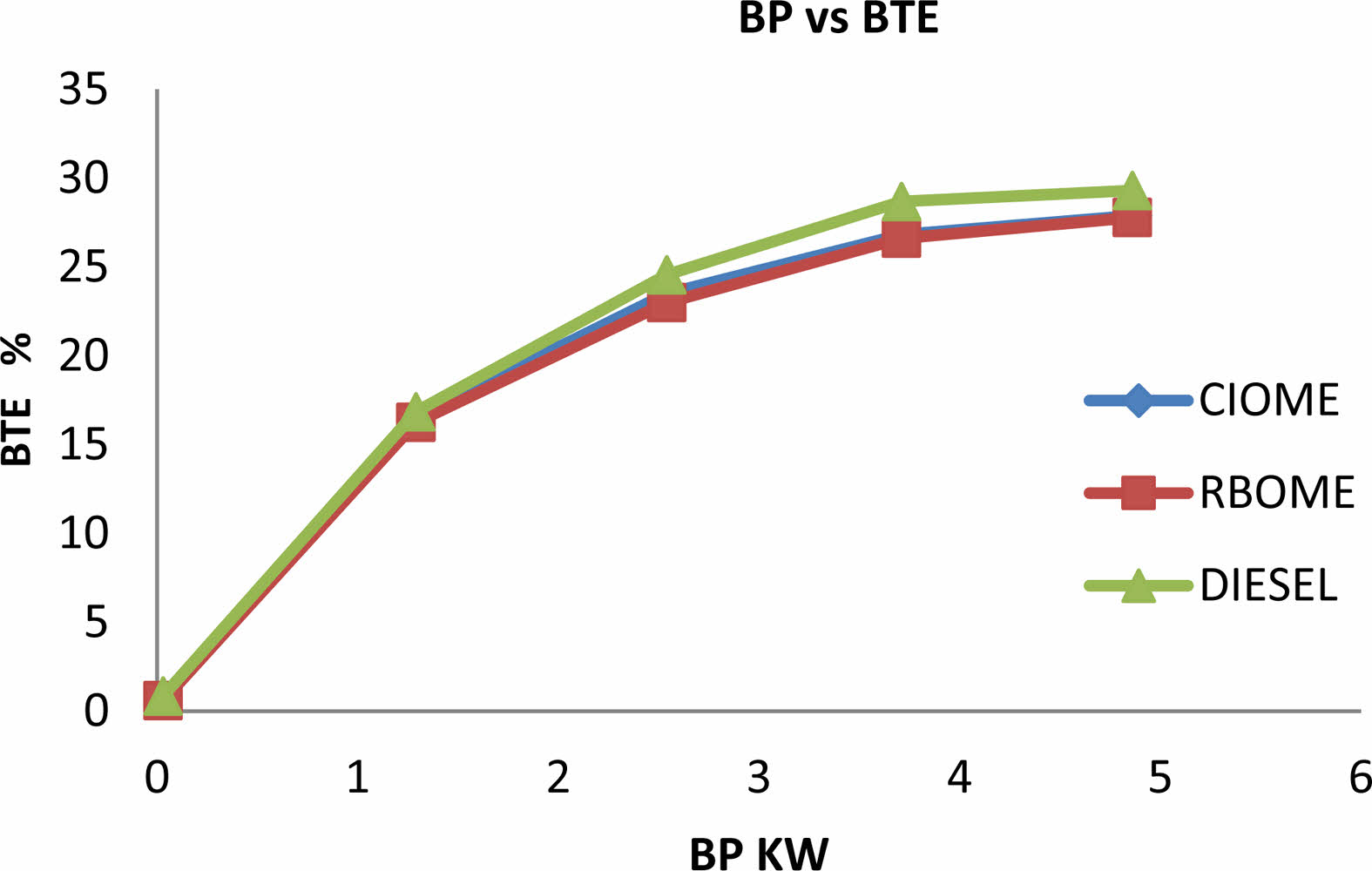
|
Fig. 3 Comparison of BTE fuelled vs BP |
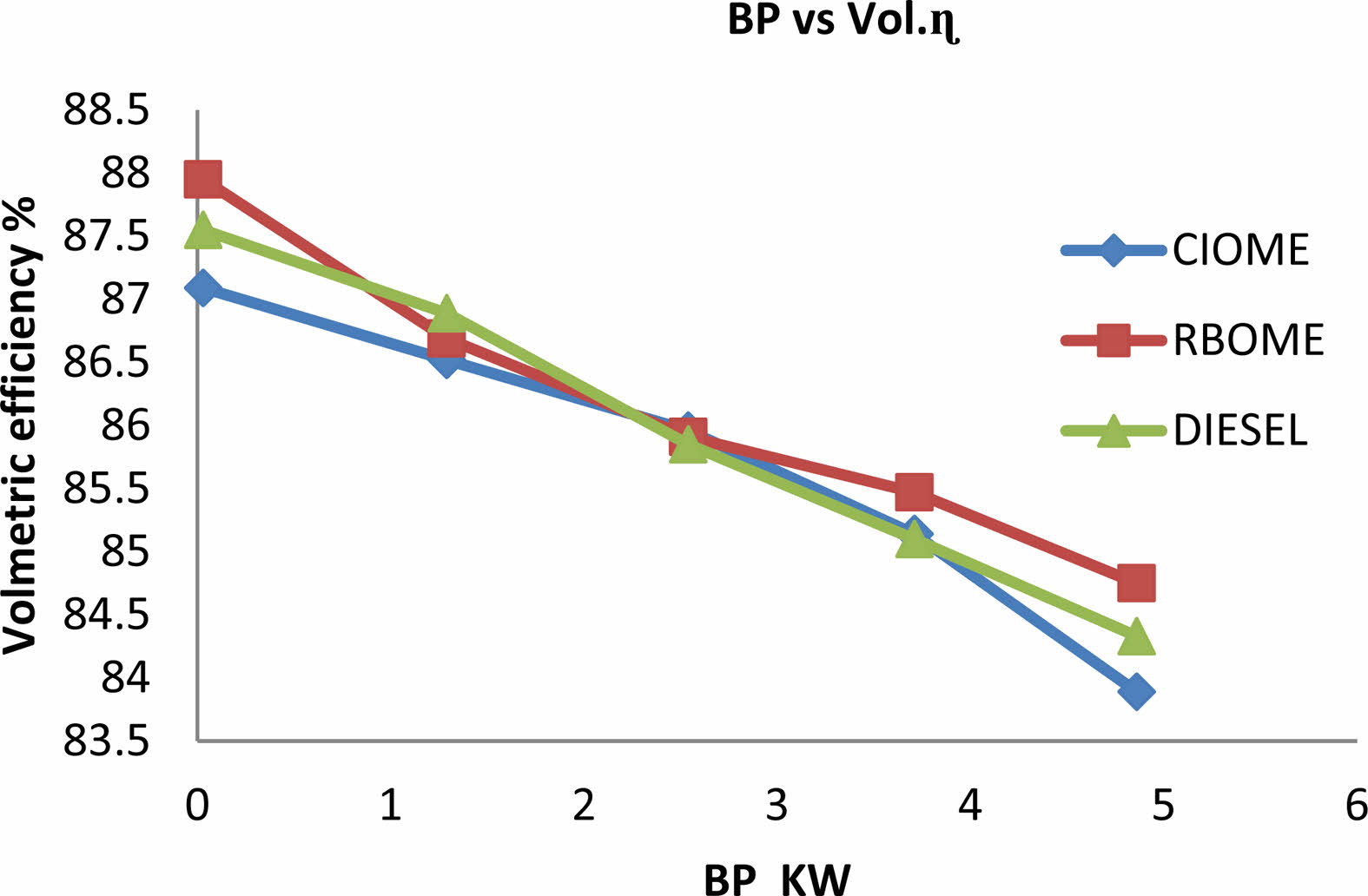
|
Fig. 4 Comparison of Vol η vs BP. |
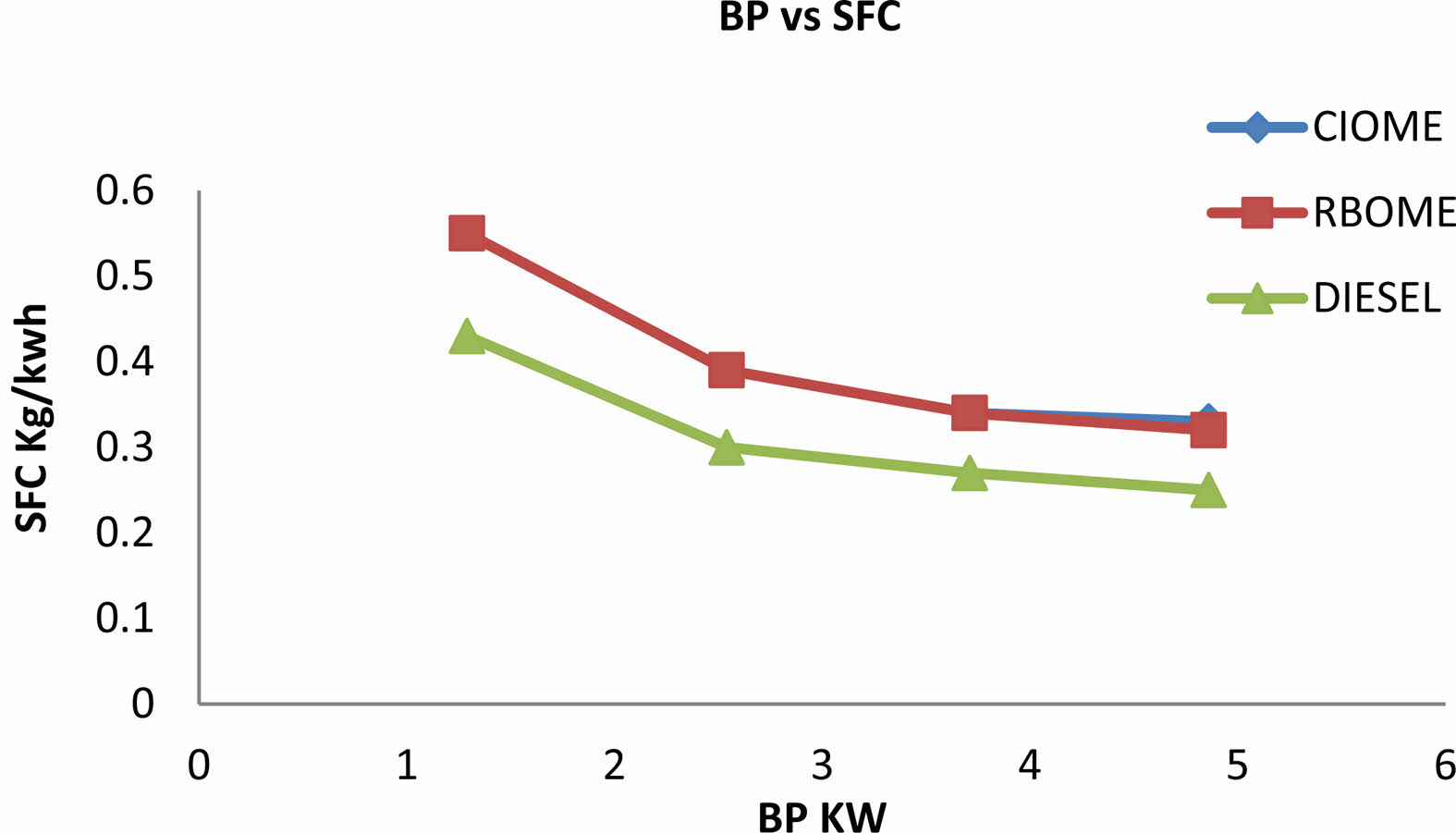
|
Fig. 5 Comparison of BSFC vs BP. |
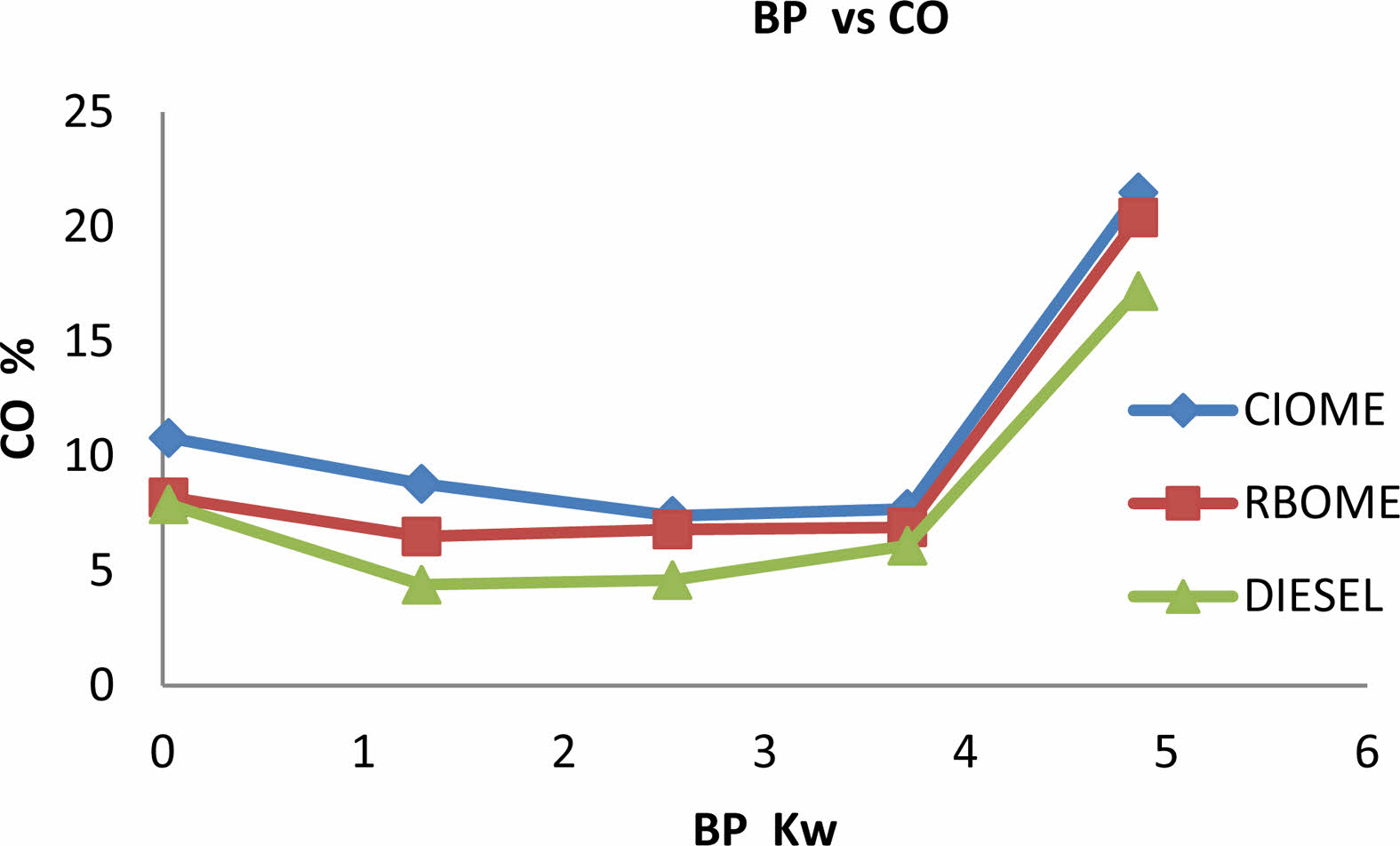
|
Fig. 6 Comparison of CO emission vs BP |
Kirloskar manufacturer TV1 single cylinder DI diesel engine shown in Fig. 2 is used as the experimental setup for the research work [24]. In this work, piston head, cylinder head, and intake and exhaust valves were coated with ceramic material using plasma spray coating technique The experimental setup also consists of a Eddy current dynamometer with electrical loading, AVL DiGas 444 analyser, AVL 437C smoke meter [25,26].
The results depicted below reveals the performance and emission characteristics of bio-diesel at various levels. The current result is an outcome of comparison of conventional engine with diesel and transesterified biodiesel CIOME and RBOME with pure diesel. The engine were tested at the constant speed of 1500 rpm and engine performance analysis and emission characteristics for unburned hydro carbon, carbon monoxide (CO), nitrous oxide (NOx), and engine smoke opacity were tested.
Engine performance characteristics
The brake powers at several loading conditions are calculated and the brake thermal efficiency is calculated for the diesel engine fuelled with pure diesel, CIOME and RBOME. Fig. 3 represents the brake thermal efficiency versus brake power characteristics. It is noted that as the engine loading increases, the brake thermal efficiency also increases due to higher heating value of the neat diesel. The brake thermal efficiency for the diesel engine fuelled through CIOME is found to be 27.88% at full load conditions where as for the diesel engine fuelled with rice bran oil at same operating conditions is 27.78%.
The brake powers at several loading conditions are calculated and the volumetric efficiency is also calculated for the diesel engine fuelled with CIOME, RBOME and neat diesel, is shown Fig. 4. It is experiential that the volumetric efficiency is actual volume of air intake is higher than the initial load conditions. The volumetric efficiency is gradually decreases with increase in brake power. The higher value of the volumetric efficiency for the diesel engine fuelled with CIOME is found to be 87.09% at no load conditions where as the volumetric efficiency for the diesel engine fuelled with RBOME at same operating conditions is 87.95%.
The brake powers at several loading conditions are calculated and the BSFC is calculated for the diesel engine fuelled with CIOME, RBOME and pure diesel is shown in Fig. 5. It is observed that the BSFC of biodiesel viz., CIOME and RBOME at the maximum torque and rated power conditions are higher than to facilitate the diesel fuel. The BSFC intended for CIOME fuel operated at 25% load conditions is estimated as 0.55 gm/kWh whereas the BSFC for diesel fuel operated same load conditions is 0.43 gm/kWh.
Emission characteristics
The CO emission for the diesel engine fuelled with pure diesel, CIOME and RBOME are presented in Fig. 6. It is found that the CO emission for the diesel engine fuel with CIOME, RBOME and diesel are 11.7, 8.2 and 7.9% respectively. The CO emission is increases with increase in brake power. The Hydrocarbon emission is investigated for the diesel engine fuelled with CIOME, RBOME and diesel as shown in Fig. 7. The hydrocarbon emission for the diesel engine fuelled with CIOME, RBOME and diesel are 11, 9 and 21 ppm respectively for diesel engine operating under no load conditions. The hydrocarbon increases with increasing load and as a result richer fuel air mixture is burned and produces more hydrocarbon due to lack of incomplete combustion.
The nitrogen oxide emission is investigated for the diesel engine fuelled with CIOME, RBOME and pure diesel as shown in Fig. 8. It is observed that the nitrogen oxide emission for the diesel engine fuel with CIOME, RBOME and diesel are 32, 78 and 124 ppm respectively for diesel engine operating under no load conditions. The nitrogen oxide emission increases with increase into brake power for all the fuel and it is reported that the nitrogen oxide emission for diesel engine fuelled with CIOME for full load conditions is 1585 ppm whereas the nitrogen oxide emission for the diesel engine for full loading condition is 1734. The emission of NOx is minimum for CIOME fuel while compared to the diesel and the highest value of nitrogen oxide emission is noted at full loading condition.
The smoke opacity is investigated for the diesel engine fuelled with CIOME, RBOME and neat diesel as shown in Fig. 9. The smoke opacity for the diesel engine fuelled with CIOME, RBOME and diesel fuel under full load conditions is 85.3, 92.3 and 81.1% respectively. It is seen with the purpose of the smoke opacity is higher for the diesel engine fueled with RBOME and low for diesel fuel. The smoke opacity for diesel engine fuelled with CIOME is 85.3% and it is very near to the diesel fuel.
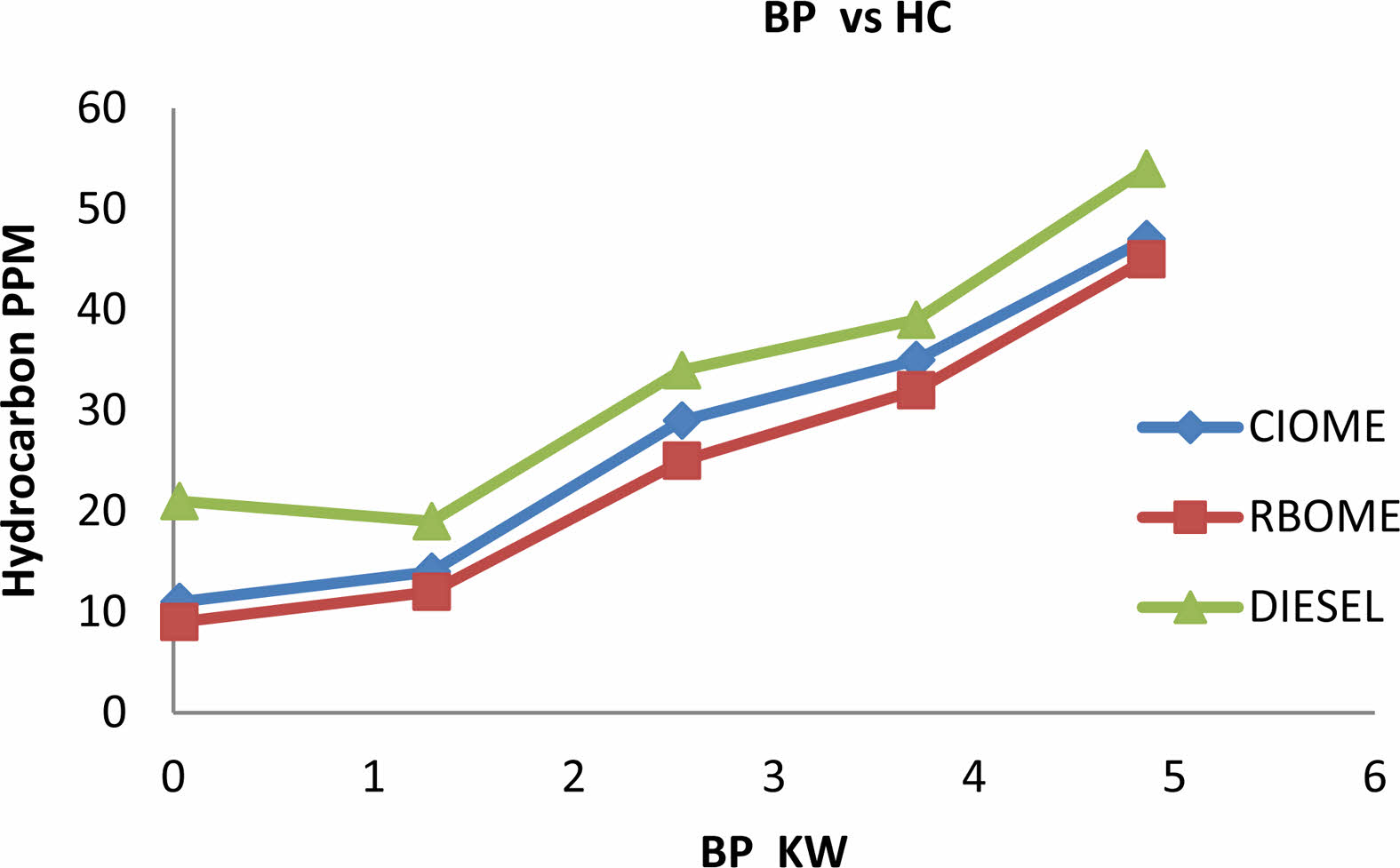
|
Fig. 7 Comparison of hydrocarbon emission vs BP. |
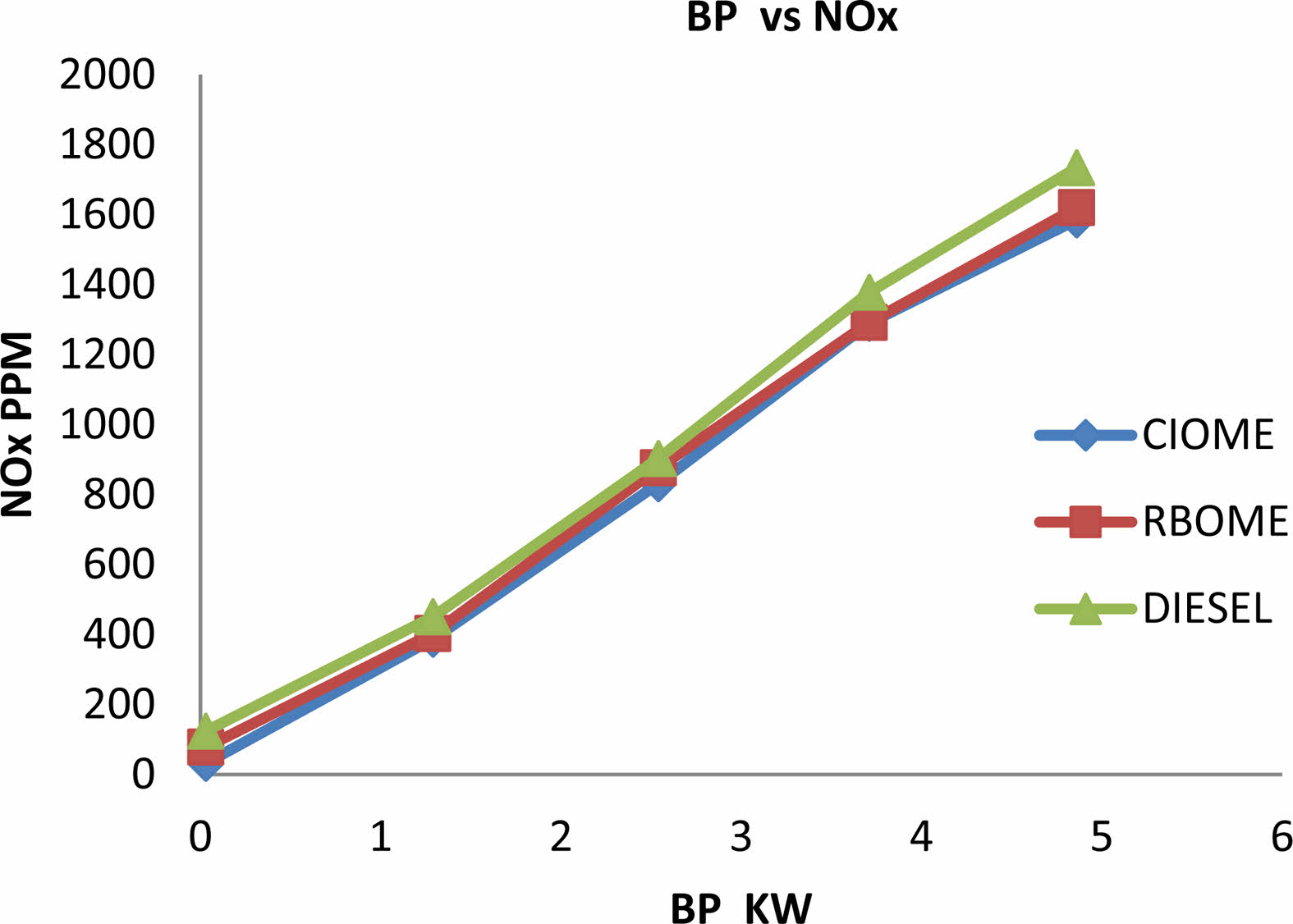
|
Fig. 8 Comparison of NOx emission vs BP. |
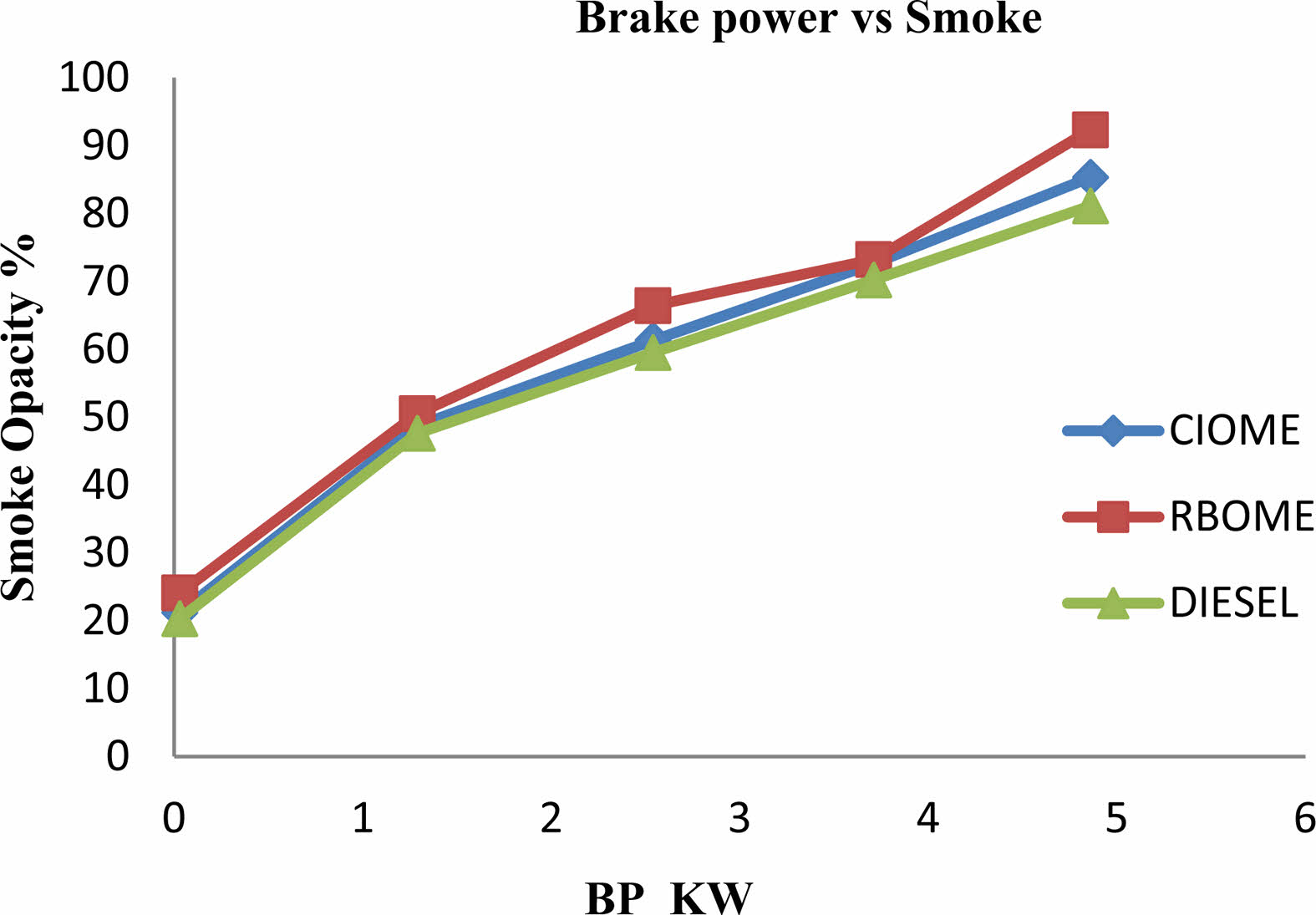
|
Fig. 9 Comparison of Smoke Opacity vs Brake power. |
The engine performance and emission characteristics of diesel engine fuelled with CIOME, RBOME and neat diesel are analyzed in this work. BSFC is analyzed for engine performance. HC, CO, NOx, Smoke opacity are analyzed for the emission characteristics. The CIOME produces best results when compared with RBOME, and Diesel. The higher level of brake thermal efficiency is observed with CIOME and it is found to be 27.88%, while the brake thermal efficiency of diesel engine fuelled through the diesel fuel at maximum load is found to be 29.67%. The brake specific fuel consumption in favor of the CIOME is found to be 0.29 kg/kWh under engine full load conditions and it is the economic value.
- 1. K. Murugan and R. Thirumalai, Mater. Tehnol. 55[1] (2021) 121-126.
-

- 2. M.J. Haas, Fuel Process. Technol. 86[10] (2005) 1087-1096.
-

- 3. M. Yao, T. Ma, H. Wang, Z. Zheng, H. Liu, and Y. Zhang, Energy 162 (2018) 744-752.
-

- 4. J.M. Marchetti, V.U. Miguel, and A.F. Errazu, Renew. Sustain. Energy Rev. 11[6] (2007) 1300-1311.
-

- 5. K.A. Gray, L. Zhao, and M. Emptage, Curr Opin Chem Biol. 10[2] (2006) 141-146.
-

- 6. J.M. Marchetti, V.U. Miguel, and A.F. Errazu, Renew. Sustain. Energy Rev. 11[6] (2007) 1300-1311.
-

- 7. L. Odling-Smee, Nature, 446[7135] (2007) 483-483.
-

- 8. A.P. Sathiyagnanam, C.G. Saravanan, and S. Dhandapani, In Proceedings of the World Congress on Engineering, 2 (2010) 1-4.
- 9. K. Masera and A.K. Hossain, J. Energy Inst. 92[3] (2019) 783-801.
-

- 10. J.W. Lee, C.H. Lee, and H.J. Kim, J. Ceram. Process. Res. 2[3] (2001) 113-119.
- 11. N.R. Banapurmath, P.G. Tewari, and R.S. Hosmath, Renew. Energy 33[9] (2008) 1982-1988.
-

- 12. A.S. Kumar, S. Yuvaraj, and S. Janaki, J. Ceram. Process. Res. 21[2] (2020) 217-225.
-

- 13. P.Q. Tan, Y.M. Zhong, Z.Y. Hu, and D.M. Lou, Energy 141 (2018) 898-906.
-

- 14. M.M. Shivashimpi, S.A. Alur, S.N. Topannavar, and B.M. Dodamani, Energy 154 (2018) 17-26.
-

- 15. V. Manieniyan, R. Senthilkumar, and V. Sukumar, Mater. Today: Proc. 37 (2021) 3665-3672.
-

- 16. N. Yilmaz, E. Ileri, and A. Atmanli, Int. J. Energy Res. 40[8] (2016) 1134-1143.
-

- 17. J. Moon, H. Choi, and C. Lee, J. Ceram. Process. Res. 1[1] (2000) 69-73.
- 18. K. Nanthagopal, B. Ashok, A. Tamilarasu, A. Johny, and A. Mohan, Energy Convers. Manag. 146 (2017) 8-19.
-

- 19. A. Bilgin, O. Durgun, and Z. Sahin, Energy Sources 24[5] (2002) 431-440.
-

- 20. A. Nalgundwar, B. Paul, and S.K. Sharma, Fuel, 173 (2016) 172-179.
-

- 21. Y.H. Tan, M.O. Abdullah, C. Nolasco-Hipolito, N.S.A. Zauzi, and G.W. Abdullah, Energy Convers. Manag. 132 (2017) 54-64.
-

- 22. C. Ozturk and T. Demircan, J. Ceram. Process. Res. 21[4] (2020) 433-441.
-

- 23. J. Dharmaraja, D.D. Nguyen, S. Shobana, G.D. Saratale, S. Arvindnarayan, A.E. Atabani, S.W. Chang, and G. Kumar, Fuel 239 (2019) 153-161.
-

- 24. A. Sharma, Y. Singh, and N.A. Kumar, Energy Sources A: Recovery Util. Environ. Eff. 41[24] (2019) 3046-57.
-

- 25. M. Kuppusamy and T. Ramanathan, Mater. Tehnol. 55[4] 509-515.
- 26. H.C. Ong, H.H. Masjuki, T.I. Mahlia, A.S. Silitonga, W.T. Chong, and T. Yusaf, Energy 69 (2014) 427-445.
-

 This Article
This Article
-
2022; 23(5): 625-628
Published on Oct 31, 2022
- 10.36410/jcpr.2022.23.5.625
- Received on Feb 25, 2022
- Revised on Jun 19, 2022
- Accepted on Jun 25, 2022
 Services
Services
- Abstract
introduction
bio diesel extraction
methodology
results and discussion
conclusions
- References
- Full Text PDF
Shared
 Correspondence to
Correspondence to
- K. Murugan
-
Dept. of Automobile Engineering, Mahendra Institute of Technology, Namakkal, India – 637503
Tel : +91-8526998303 - E-mail: muruganauto@gmail.com






 Copyright 2019 International Orgranization for Ceramic Processing. All rights reserved.
Copyright 2019 International Orgranization for Ceramic Processing. All rights reserved.